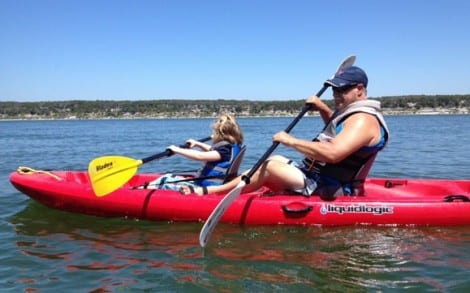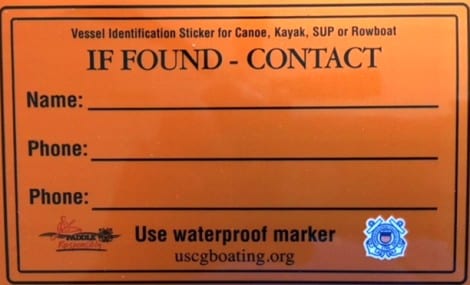 By Bob Currie, Vessel Examiner
By Bob Currie, Vessel Examiner
United States Coast Guard Auxiliary Station Galveston Flotilla.
Operation Paddle Smart
One thing is certain: if we get lost at sea, the US Coast Guard will come searching for us. But it is up to the vessel operator to do everything possible to make that search easy. We do that by registering our vessels as required, having proper emergency communication devices such as marine radios, Emergency Position Indicator Beacons (EPIRBs), and Personal Locator Beacons (PLBs); by filing float plans, and by generally being safe boaters.
The Station Galveston Flotilla of the US Coast Guard Auxiliary operates out of the USCG Station Galveston base on Galveston Island. They provide assistance to the Coast Guard by providing maritime observation patrols in Galveston Bay; by providing recreational boating vessel safety checks; and by working alongside Coast Guard members in maritime accident investigation, small boat training, watch standing, and property administration.

Me with granddaughter Anna
One type of call our Coast Guard Watchstanders receive is the Unmanned Vessel Report. This is a call in which another vessel reports finding a boat, kayak, canoe, or other paddle craft at sea with no one aboard. When small craft such as kayaks or canoes are found adrift, typically there is no way of determining whether or not individuals may be in distress. In such situations, having timely access to some basic information can make all the difference between wasting valuable SAR resources and saving lives.
With a registered vessel, the Coast Guard can attempt to locate the owner based upon the information provided during the registration process. But it is far more difficult to find owner information for paddle craft, especially for those paddle craft with no registration number or no Hull Identification Number (HIN). Often a vessel has come loose from its mooring or been floated off the beach or dock by a high tide and simply floated out to sea. But that information is not known at the time we receive an unmanned vessel report. In the meantime, the Coast Guard must treat that unmanned craft as a true emergency, and activate the Search and Rescue (SAR) system. But there is something you can do as a paddle craft owner: apply a Coast Guard “Vessel Identification Sticker for Canoe, Kayak, SUP or Rowboat.” The ID sticker was developed as part of Operation Paddle Smart.
The canoe, kayak, SUP or rowboat identification sticker is one of our most popular stickers. It is metallic orange, waterproof, and really sticks to the side of your vessel. All you need is a waterproof marker to add your information to the sticker. The Coast Guard has asked us to distribute these as much as possible. On July 4 this year they performed 32 search and rescue missions due to finding unmanned kayaks floating in open waters. It was determined that all 32 cases were due to kayaks floating off from shore. Not a single kayak had any identifying information such as the orange ID sticker. I have a supply of these stickers. Please contact me if you would like one for your paddle craft.

Filing a Float Plan
Paddle craft operators should regularly file a float plan before using their vessels, even for short trips. It can be an informal document to tell a person on shore where the operator is planning to go, what time he or she is likely to return, which authorities to call if the boat does not return as scheduled, and how to describe the vessel to first-responders. The best float plan I have ever seen is included in the Coast Guard app that you can download to your cell phone.
Prepare For the Worst
Paddle craft operators should carry whatever equipment will be needed to cope with the worst situation they are apt to encounter on a specific trip, including a life jacket, throw bag, towline, compass, signaling devices, spare paddle (or tether the one paddle), gloves, sun glasses, and a hat with a brim. Don’t forget that knife. If you bring your cell phone, use a bag designed to keep it dry or one of those waterproof covers. There are some nice paddling gloves out there. It is a rough trip in with blisters on your hands.
Be Visible To Other Boaters
Paddlers should take steps to ensure that boaters in larger vessels will be able to see them relatively easily, even in rough water, high traffic areas, and reduced visibility. That means wearing high visibility clothing and accessories whenever possible. You must have an all round white light if you are going to operate at night.
Stay Away from San Luis Pass
We have had our first area boating fatality early this year. It only took 3 days. It happened near the infamous San Luis Pass, and the boater was in a kayak. San Luis Pass is a dangerous, as well as illegal, place for recreational water activities. Citing unsafe conditions, the Brazoria County Commissioner’s Court voted to ban visitors from entering the water for recreational activities. The ban, which went into effect August 18, 2017, prohibits visitors from “entering the waters of the San Luis Pass for any activity, including bathing, fishing and/or swimming.”
Check the Weather Forecast
Do not kayak in windy weather. Even powerboaters know to avoid windy weather. Obtain an accurate forecast, and monitor the weather using the weather channel on your marine radio, and scan the sky frequently for bad weather developing, especially between you and the shore. If the weather changes for worse, head for shore.
Don’t Kayak Alone
You should never launch your kayak without a partner. Your kayaking partners should have their own kayaks as well. I have a kayak designed for either solo or two person operation. Winter time is not the time to double up in a kayak. That kayaking partner is of no help to you if they are in the boat with you when it capsizes.
No Alcohol
An impaired kayaker is at the highest risk for a serious accident before they even hit the water. Not only is your judgment seriously compromised, so is your ability to survive an immersion. An alcohol-impaired kayaker is more likely to drown due to the gasp reflex than a sober kayaker. The gasp reflex causes you to inhale water when you are suddenly immersed in water that is cold or even cool.
 Have Some Form of Communication
Have Some Form of Communication
I am a firm believer in having a marine FM/VHF radio on board at all times, but if you don’t have one, at least have a cell phone with the Coast Guard app downloaded onto it. Things can go south so fast, and you need to keep your radio or phone within reach at all times. If you have a DSC-enabled marine radio, be sure to obtain an MMSI (Maritime Mobile Service Identity) and program it into your radio. The emergency distress button doesn’t work unless you do. I keep my marine radio in my life jacket pocket.
Stay Close to Shore
As you travel away from the shore, make sure you have the strength and skills to paddle back. Stay away from all boats and traffic patterns. If you need to cross the Intracoastal Waterway, do it quickly and when there is no traffic approaching. Stay apprised of tidal currents, also known as rip currents, and their effects on you and your kayak. Tidal currents are part of the danger at San Luis Pass. If in doubt, don’t go out.
Recommended Equipment
Although most of the items listed below are recommended for any time of year, many of the items become more important when the weather and water temperatures are cooler.
- Whistle (required by regulation; best if attached to your life jacket)
- Marine VHF/FM radio with Digital Selective Calling
- Spare paddle (I had a paddle blade break off while I was about 3 miles offshore)
- Paddle tether (most paddles don’t float)
- Hat (protect your ears from the sun also)
- UV eye protection (sunglasses)
- Sunscreen (you can burn even in winter)
- Drinking water and snacks
- Proper footwear (flip flops won’t cut it; think oyster shell bottom)
- Knife (a fixed blade is better than a folding blade in emergencies)
- Self-rescue devices (tow rope, throwbag with line, duct tape)
- Dry bag with spare clothing and towel
- Compass (if fog sets in, you are going to need it)
- First aid kit (rope burns, lacerations)
Just What Are the Dangers
Sometimes it helps to think in terms of the actual dangers in order to prepare us for an emergency situation. The list below is not exhaustive, and it is not in any order of likelihood or severity of risk. It is simply some of the things you are up against. Contemplate this list, or make your own, every time you go out, and that alone will help you prepare mentally for an emergency.
- Capsizing (well, this IS the number one risk on any list)
- Getting run over by a powerboat or ship (higher risk than you would imagine)
- Getting sucked out to sea (remember San Luis Pass)
- Sinking (check your kayak for holes or leaks; watch for submerged objects)
- Exposure (wind, heat, cold; we had an exposure death in 2017)
- Losing or breaking a paddle (use a tether)
- Getting lost (night time, fog, getting too far out to see land)
- Injuries (sun/wind burn, lacerations, rope burns, venomous sea life injuries)
- Heart attack (or any other life threatening illness due to a pre-existing condition)
- Dehydration (it happens even in cold weather)
Motorizing Your Kayak
There are several motors designed to attach to a kayak. Some are electric, some are gas powered, and some are propane powered. If you decide to attach one to your kayak, understand that your kayak then becomes a powerboat under both federal and state regulations, and Texas requires the kayak to be registered and display state numbers. This only applies to motors, so if you have a kayak with a propeller or other manual drive system, it is still a kayak under the regulations.
Summary
Part of the allure of paddle craft is the ability to simply put it in the water anywhere and take off. Resist this temptation unless you have taken the time to prepare for your safety. Paddle craft and heavy surf do not go together, yet I see dozens of people trying to use them in the surf, and they rarely have life jackets on, let alone have any idea of the dangers they face. I now have had two people tell me they don’t need a life jacket because they are excellent swimmers. As I pointed out to both, it is impossible to swim if you are unconscious, and it doesn’t take much of a hit on the head to make you so.
For more information on boating safety, please visit the Official Website of the U.S. Coast Guard’s Boating Safety Division at www.uscgboating.org. Questions about the US Coast Guard Auxiliary or our free Vessel Safety Check program may be directed to me at [email protected]. I am available to perform free Vessel Safety Checks, and I will come to your location to perform them. SAFE BOATING!
[7-15-2019]

 Posted in
Posted in 























